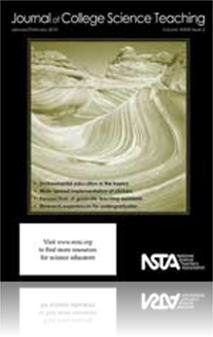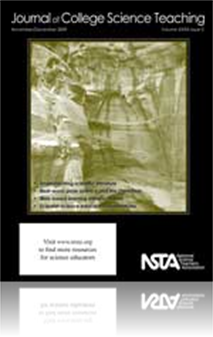All Journal of College Science Teaching resources
Journal Article
A Case-Based Approach Improves Science Students’ Experimental Variable Identification Skills
Incorporation of experimental case studies into the laboratory curriculum increases students’ abilities to identify experimental variables that affect the outcome of an experiment. Here the authors describe how such case studies were incorporated u...
Journal Article
Students are scientifically literate when they can read material about science and intelligently communicate their viewpoints, comments, and critiques, using scientific vocabulary and applying the ideas of the process and nature of science. As part o...
Journal Article
Building Acceptance for Pedagogical Reform Through Wide-Scale Implementation of Clickers
Many instructional strategies exist that address poor student success in the sciences. They often go untapped, however, due to the knowledge or time needed for implementation. This article presents a formula for success that has encouraged a signific...
Journal Article
Worms in the College Classroom: More Than Just a Composting Demonstration
Although worm bins have been used by K–12 and nonformal educators for decades, there is little evidence of their use in postsecondary education. The ease of use, maintenance, affordability, portability, and diversity of scientific concepts that can...
Journal Article
Point of View: How Are We Reforming Teaching in Undergraduate Science Courses?
A study of a national population of 103 higher education institutions is addressing the question: What criteria can be used to identify the level of implementation of reform in an undergraduate science course? Results of a survey characterizing the i...
Journal Article
Favorite Demonstration: Structure—Function Lab in a Bag
This hands-on activity stimulates students to consider the close relationship between structure and function. This inquiry-type lab can be done as a group or cooperative learning experience using simple kitchen tools. The activity provides a fun ice-...
Journal Article
Bridging the Gap Between Real-World Polar Science and the Classroom
The International Polar Year—Research and Educational Opportunities in Antarctica for Minorities (IPY-ROAM) program was designed to increase minority participation in polar science by immersing participants in an academic program that included a tr...
Journal Article
This article describes a research study in which a biologist and his research on Antarctic seabirds became part of an integrated science course for prospective elementary teachers. Students used the scientist’s database on seabird chick growth rate...
Journal Article
A Versatile Module to Improve Understanding of Scientific Literature Through Peer Instruction
Using primary literature in undergraduate science classes helps teach students both scientific information and process. However, students’ lack of understanding of scientific techniques can hinder their understanding of the papers. This article des...
Journal Article
Attitudes toward science may develop as early as middle school and often differ between genders. Do these gender-based differences in attitude persist into the college years? In a survey of 376 university students, male students reported a stronger s...
Journal Article
This study is an experimental introduction of web-based lecture delivery into a majors-level introductory biology course. Web-based delivery, achieved through the use of prerecorded Voice-Over PowerPoint video lectures, was introduced on a limited ba...
Journal Article
Application of the K-W-L Teaching and Learning Method to an Introductory Physics Course
The K-W-L method of teaching is a simple method that actively engages students in their own learning. It has been used with kindergarten and elementary grades to teach other subjects. The authors have successfully used it to teach physics at the coll...



